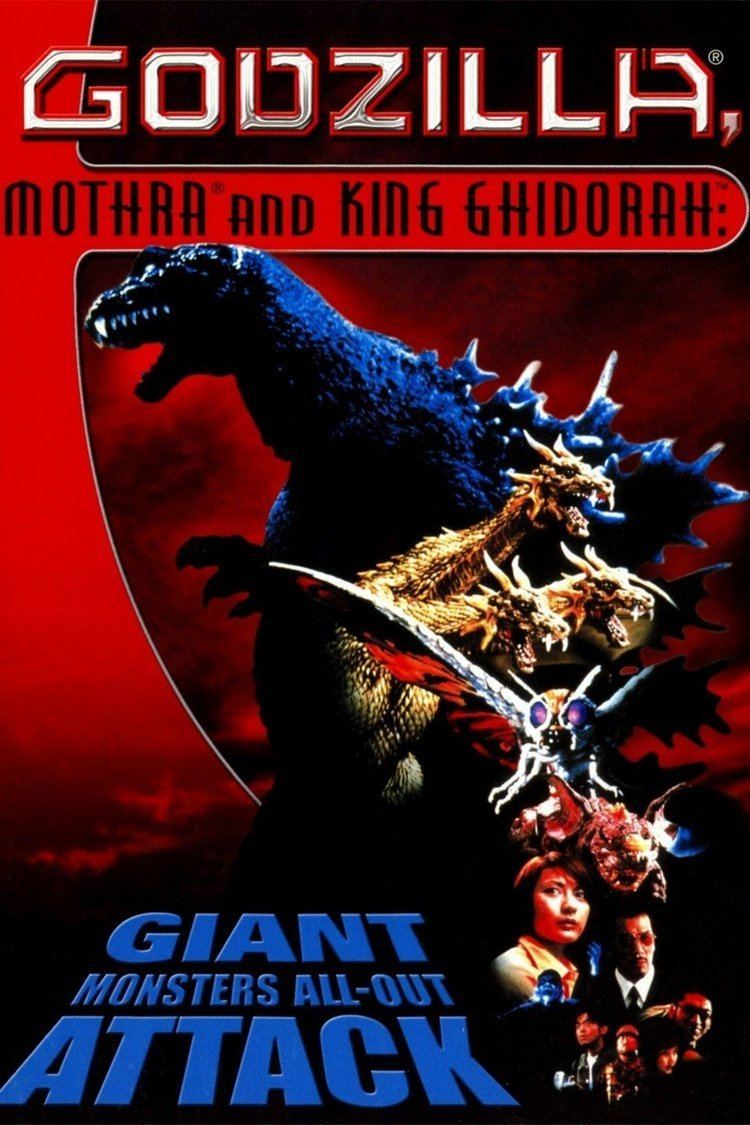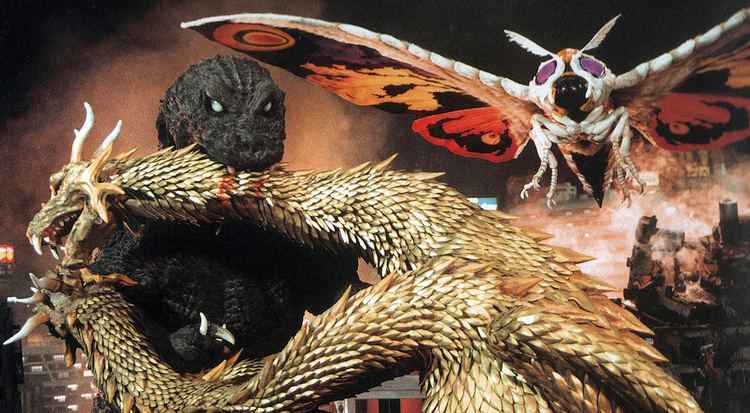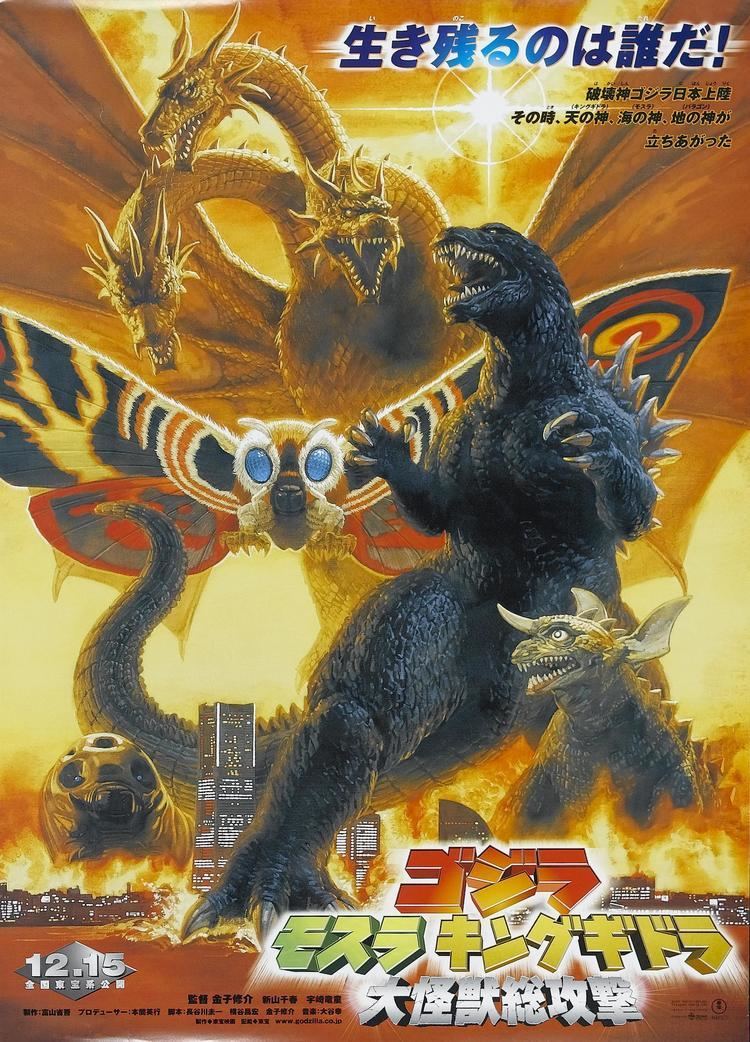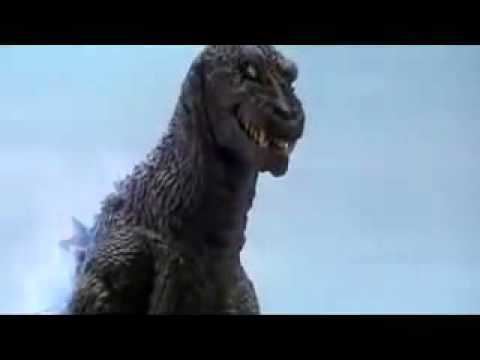6 /10 1 Votes
50% Rotten Tomatoes Initial release 15 December 2001 (Japan) Budget 9.4 million USD Music director Kow Otani | 7.2/10 IMDb Directed by Shūsuke Kaneko Cinematography Masahiro Kishimoto Director Shusuke Kaneko Box office 20 million USD | |||||||||||||||||||||||||||||||||
 | ||||||||||||||||||||||||||||||||||
Produced by Shogo TomiyamaHideyuki Honma Written by Keiichi HasengawaMasahiro YokotaniShusuke Kaneko Starring Chiharu NiiyamaRyudo UzakiMasahiro KobayashiShiro SanoTakashi NishinaKaho MinamiShinya OwadaKunio MuraiHiroyuki WatanabeShingo KatsurayamaTakeo NakaharaToshikazu FukawaHideyo Amamoto Cast Similar Godzilla movies, Dragon movies, Monster movies | ||||||||||||||||||||||||||||||||||
Godzillathon 26 godzilla mothra and king ghidorah giant monsters all out attack 2001
Godzilla, Mothra and King Ghidorah: Giant Monsters All-Out Attack (ゴジラ・モスラ・キングギドラ 大怪獣総攻撃, Gojira, Mosura, Kingu Gidora: Daikaijū Sōkōgeki, also known as GMK) is a 2001 Japanese science fiction tokusatsu kaiju film featuring Godzilla, produced and distributed by Toho. It is the 26th film in the Godzilla franchise, the 25th Godzilla film produced by Toho, and the third film in the Millennium series. The film is directed by Shūsuke Kaneko, written by Kaneko, Keiichi Hasegawa, and Masahiro Yokotani, and stars Chiharu Niiyama, Ryudo Uzaki, Masahiro Kobayashi, Takashi Nishina, Kaho Minami, Shinya Owada, Kunio Murai, Hiroyuki Watanabe, Shingo Katsurayama, Takeo Nakahara, Toshikazu Fukawa and Hideyo Amamoto. Like the other Millennium films, this is a direct follow-up to the original Godzilla film and ignores the events of the Shōwa and Heisei series.
Contents
- Godzillathon 26 godzilla mothra and king ghidorah giant monsters all out attack 2001
- Plot
- Cast
- Production
- Box office
- Home media
- English version
- Critical reception
- Awards
- References

Plot

During a meeting of the Japan Self-Defense Forces (JSDF) for the potential return of Godzilla, Admiral Taizo Tachibana briefs cadets about Godzilla's first attack. A nuclear submarine is reported missing, which is later found to have been destroyed by Godzilla. Tachibana's daughter, Yuri Tachibana films a docudrama with her crew at Mt. Myoko, where a mysterious earthquake randomly ensues. The odd earthquake returns later that night burying a biker gang and leaving one surviving trucker who witnesses the monster, Baragon.

The next day, Yuri is unable to convince her supervisor Haruki Kadokura to report the incident. The JSDF attempts to rescue the buried men using their D-03 missile. The surviving trucker tries to explain to a military official what he saw but can only explain that he believed it was Godzilla. Yuri's friend, Teruaki Takeda, supports her theory that a monster may have been the cause of the mysterious Myoko earthquake by giving her a book on The Guardian Monsters.

While Mothra attacks a group of teenagers at Lake Ikeda in Kagoshima, the JSDF analyzes underwater footage of what appears to be glowing dorsal fins leaving the destroyed nuclear submarine from before. The conclusion is drawn that the monster is Godzilla. Yuri interviews Hirotoshi Isayama, an elderly man who foretells the return of Godzilla. Isayama explains to her the legend of the guardian monsters, Baragon, Mothra, and King Ghidorah and goes on that they must be awakened before Godzilla destroys Japan. Yuri and her team visit the guardian monsters shrine where she finds a stone. Godzilla comes ashore to Magonote and attacks the Bonin Islands, leaving few survivors. Yuri returns to interview Isayama, and discovers that the souls of those who were killed by the Japanese in World War II are embedded within Godzilla, and wish to destroy Japan as punishment for people's attempts to forget Japanese wartime atrocities.

A few days later, Godzilla and Baragon battle in Hakone; Godzilla is victorious and Yuri is injured. When Takeda refuses to take her to Godzilla's location, Yuri leaves. Mothra's cocoon is soon immediately discovered in Lake Ikeda. The JSDF dispatch several fighter jets to fight Godzilla but are wiped out. Tachibana sets up a defense line in Yokohama. Mothra and a yet-to-be-grown Ghidorah awaken and fly towards Yokohama to fight Godzilla. The JSDF incapacitates Ghidorah and Mothra but fail to stop Godzilla.
Furious, Godzilla wipes out the defense line and later kills Mothra. Mothra's spirit merges with Ghidorah and transforms it into the 3,000-year-old dragon King Ghidorah. King Ghidorah injures Godzilla and they fight underwater. Tachibana and his colleague join the fight using the Satsuma submarine. Tachibana attempts to shoot the D-03 into Godzilla's wound but fails Yuri and Takeda report the struggle from a bridge that later collapses from Godzilla's atomic breath.
The shrine stone falls from Takeda's pockets and merges with King Ghidorah's head. Yuri and Takeda barely survive the fall and swim to the shore while the monsters continue to fight. Godzilla destroys King Ghidorah, unleashing the spirits of the Guardian Monsters, which sink Godzilla down to the deep. After entering Godzilla's body through its mouth, Tachibana is able to use a D-03 missile on Godzilla's wound. Godzilla surfaces to confront Yuri and Takeda, but the D-03 wounds Godzilla. Godzilla attempts to kill Yuri and Takeda, only to sink once more beneath the water. Tachibana escapes from Godzilla as the monster disintegrates. Japan soon rejoices at their victory against Godzilla, but its disembodied heart is still beating on the ocean floor.
Cast
Production
Director Shūsuke Kaneko cycled through various script ideas when attempting to conceive this film. In the earliest known script, Godzilla would have faced off against a revamped version of Kamacuras, but this idea was scrapped since Godzilla had fought another insect-like kaiju in the previous film (Godzilla vs. Megaguirus). A second idea involved Godzilla battling a new alien monster in a futuristic setting, but the script was considered too dark for a Godzilla film. The Guardian Monsters concept came next, though Kaneko's original script originally had Anguirus, Varan and Baragon defend Japan against Godzilla. Toho told him to replace the former two with the more popular King Ghidorah and Mothra, as Anguirus and Varan were not considered bankable enough to guarantee a box-office hit. Skeptical at first, he managed to work the two monsters into the film..
The film is especially notable for the changes made to the monsters. For example, Ghidorah typically played the villain in previous Godzilla films; this film has him as a hero. In fact, Ghidorah is actually portrayed a few meters shorter than Godzilla; previous incarnations of the character were much larger, and towered over Godzilla.
Originally, Godzilla was intended to walk with his back and tail parallel to the ground however, this idea was dropped due to the strain it put on Mizuho Yoshida (the actor playing Godzilla), and Godzilla retains his traditional posture.
Mothra was also revamped. Like Ghidorah, Mothra is portrayed as being far smaller than normal and looking more like a Butterfly than a Moth. Her poison powder and hurricane wind attacks were removed, and were replaced with a burst of stingers fired from her abdomen. In addition, Mothra's fairy servants, the Shobijin, are dropped completely, (though a homage exists in the form of twins from Gamera 3: Awakening of Irys who look up in awe at Mothra as she flies overhead).
Baragon was also altered. His heat ray was removed, his roar was changed and his horn is no longer bioluminescent.
Apparently, the reason behind the changes to Ghidorah, Mothra, and Baragon were made in order to make Godzilla seem stronger. Director Kaneko wanted Godzilla to be the most powerful monster in the film. He originally wanted to use monsters who are notably smaller and less powerful than Godzilla, as his opponents. When advised by Toho to replace them, he compensated by making Ghidorah and Mothra weaker than they normally were. Fuyuki Shinada, who designed the monster suits for the film, was disappointed that Varan (his all-time favorite monster) wasn't going to be in the film, so he compromised by putting Varan's facial features on Ghidorah's three heads.
In addition, the radioactive element has been replaced with a more mystical element. Godzilla has origins rooted in Japan's World War II past. Although Godzilla is still a mutant dinosaur created by the atomic bomb, he is also described as an incarnation of those killed or who were left to die at the hands of the Imperial Japanese Army during the Pacific War. The extent to which his nuclear and spiritual origins balance is never specified. Kaneko, a lifelong pacifist, wanted to give the film an anti-war angle. The nuclear origin was left in because he knew that audiences wanted a realistic Godzilla, but he thought it worked better with a fantasy element.
Box office
Produced with a budget of $9,400,000, Godzilla, Mothra and King Ghidorah: Giant Monsters All-Out Attack opened in Japan on December 15, 2001 on a double-bill with an animated film called Hamtaro: Ham Ham Big Land Adventure. In its opening weekend, it grossed approximately $1,900,000. By the end of its box office run, Godzilla, Mothra and King Ghidorah: Giant Monsters All-Out Attack grossed a total of approximately $20,000,000, with 2,400,000 admissions. It was one of the largest-grossing Godzilla films of the Millennium series in Japan.
Home media
The film was released on DVD on January 27, 2004, and was released on Blu-ray, bundled with Godzilla Against Mechagodzilla, on September 9, 2014.
English version
After the film was completed, Toho had their international versions of the movie dubbed in Hong Kong. This dubbed version significantly changes the meaning of several lines throughout the film.
Sony licensed GMK and Godzilla vs. Megaguirus with the hope of giving both films a theatrical release in the United States. Sony's release of Godzilla 2000 proved that traditional Godzilla films failed to attract huge crowds of moviegoers, so plans to give any newer Godzilla films a wide release were scrapped.
Instead, Sony prepared edited television versions of both films. These premiered in the United States on the Sci-Fi Channel on August 31, 2003, during the channel's Labor Day marathon. In February 2004, the uncut international versions of both films were released on DVD with the addition of the original Japanese soundtracks (a first in the US).
Critical reception
The film received mixed to positive reviews, with film review aggregator website Rotten Tomatoes reporting a 50% rating from critics, based on 14 reviews with an average score of 5.1/10. Troy Guinn of Eccentric Cinema gave the film a score of 8/10, calling it "one of only three Godzilla films I would recommend to anyone besides giant monster-movie fans or sci-fi buffs, the other two being the original Gojira and Mothra vs. Godzilla." Bryan Byun of DVD Verdict gave it a positive review, calling it "one of the most exciting entries in Godzilla's long cinematic history." Stomp Tokyo gave the film a score of 3/5, calling it "one of the better-looking entries in the series, albeit one of unfulfilled potential." John Wallis of DVD Talk felt that "the story is quite weak and somber" and that "this new take on [Godzilla] doesn't really work," while Gemma Tarlach of the Milwaukee Journal said that "GMK is best when it embraces its unabashed cheesiness. But when it tries to make Statements with Meaning, whether on Japan's past aggressions or ersatz samurai ruminations on the duty of a warrior, the movie flounders like a giant lizard hogtied by power lines." Film critic Leonard Maltin gave it three out of four stars, one of only two Godzilla films to receive more than two and a half stars, with the other being Godzilla 2000.
